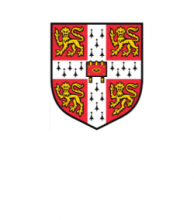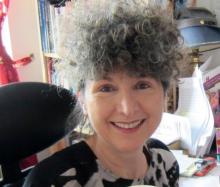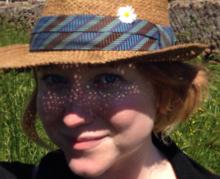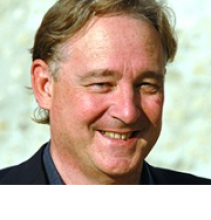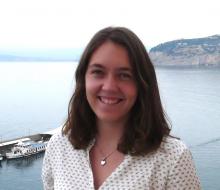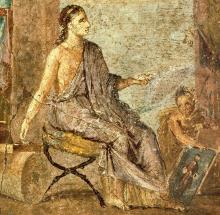The Cambridge School Classics Project is part of the Faculty of Education at the University of Cambridge, and has been supporting Classics Education for over 50 years. Amarantus and his Neighbourhood is the first of their 'Classics in the Curriculum' initiatives, which aim to encourage teachers from a range of subject backgrounds to engage with the Ancient World in their classrooms. For more information about their work, including the famous Cambridge Latin Course, please visit their main website.
Children’s author Caroline Lawrence read Classics at UC Berkeley & Newnham College Cambridge and also studied Hebrew & Jewish Studies at University College, London. She is best known for her million-selling series of historical novels for children, The Roman Mysteries. In 2007 & 2008, the BBC made a glossy children's TV series based on these books. In 2009, Caroline won the Classical Association Prize for 'a significant contribution to the public understanding of Classics'. Passionate about Latin and the world of ancient Rome, she is thrilled to be in a ‘writer’s room’ full of historians, archaeologists and creative trailblazers working on a new addition to the beloved universe of Caecilius.
Dr Sophie Hay is an archaeologist and worked on the Insula I.9 Pompeii Project for the British School at Rome in collaboration with The University of Reading. She is currently working at the University of Cambridge as a Post-doctoral Research Associate on a Pompeii project ― The Bar of Amarantus and his Neighbours ― that focuses on the publication of the excavations of the Insula I.9 Project. She was awarded a doctorate from the University of Southampton based on the results of her fieldwork in Pompeii; designing and implementing a system to record standing buildings. This then formed the basis for the chronological analysis of a block of houses with a view to understanding the development of a group of non-elite houses through time. She has project managed over one hundred geophysical surveys and has worked on a vast number of archaeological sites in Italy as well as further afield in Sudan, Libya, Turkey and Tunisia.
For Sophie, watching the individuals she has studied for so long coming to life for this project has been an incredible experience, and she cannot wait to share her work and passion for Pompeii with students and teachers. Any photographs in the materials or on the website, unless otherwise attributed, belong to Sophie and we are very grateful for their use.
Teacher and illustrator Laura Jenkinson-Brown — having been brought up in the museums of London — read English Studies and Classics at Durham University before completing her PGCE in English teaching and becoming an English and Classics teacher, with a stint as a bookseller along the way. She is now best known for Greek Myth Comix where she creates comic versions of the Greek and Roman myths and epics to educate and inspire; including comic revision guides for the Odyssey and the Life of Heracles, and an infographic on Deaths in the Iliad, all of which are used in classrooms and lecture theatres around the world. She is ecstatic to be part of such an exciting team and privileged to be adding to the Caecilius extended universe.
Professor Andrew Wallace-Hadrill is Professor of Roman Studies and Director of Research for the Faculty of Classics, University of Cambridge. A former Director of the British School at Rome, he works on Herculaneum, Pompeii, Roman urbanism, public and private space, and Roman cultural identity. In 2013, to accompany the opening of the British Museum exhibition Life and death in Pompeii and Herculaneum, Andrew presented the BBC documentary The Other Pompeii: Life and Death in Herculaneum. Andrew directs the Herculaneum Conservation Project and has been outspoken about the need to preserve the astonishing sites of Pompeii and Herculaneum in order to enable us to explore and learn from them for years to come.
Dr Olivia Elder is an ancient historian with interests in bilingualism, Roman identity, inscriptions and graffiti. She currently holds a CRASSH/British School at Rome Research Fellowship at the University of Cambridge, having recently submitted her PhD in the Faculty of Classics at Cambridge. Her thesis examined the relationship between language and Roman identity, focusing on instances of bilingualism. The Greek and bilingual graffiti of Pompeii formed one of her central case studies. Prior to her PhD, Olivia completed a BA in Ancient and Modern History and an MSt in Roman History at the University of Oxford. Her first book, co-authored with Alex Mullen, The language of Roman letters: bilingual epistolography from Cicero to Fronto, is forthcoming with Cambridge University Press. Having herself learnt Latin with Caecilius, Olivia is very excited to be working with the Cambridge Schools Classics Project and helping students discover the evidence of Pompeii (especially the graffiti!).
A project like Amarantus needs the help and support of a wide variety of people, all of whom have been crucial to its creation. The following individuals are owed our thanks for their contributions.
Stephany Ungless brought the Amarantus materials to life with her design skills, and is reponsible for the entire design scheme. She did this working alongside Charlie Andrew who created the overall concept of the site.
We are also grateful to Rob-Hancock-Jones for his great insights during the shaping of the project as a whole and contributions to the creation of the teaching resources. Dr Erica Rowan kindly allowed use her research to form the basis of the teaching materials in Topic 6.3, and Rachel Foster permitted Topic 2.3's resources to be based on her lesson resources on Pompeii.
Alison and Melvin Cooley have our sincere thanks for the use of their translations of various Pompeian graffiti and inscriptions, all taken from Pompeii and Herculaneum: A Sourcebook (Routledge Sourcebooks for the Ancient World).
The incredible, vibrant reconstructions of the bar of Amarantus and neighbouring buildings were created by motion designer and illustrator Gareth Blayney in collaboration with Dr Hay. He kindly agreed to their use in this project to help inspire fascination and curiosity regarding the Ancient World in future generations.
Finally, the Amarantus materials would not be anywhere near as engaging and informative without the images we have been able to use. Please do look at our Topic-by-Topic image attributions.pdf; our sincere thanks goes to all who give permission for their images to be used in projects such as this. Gratias!


